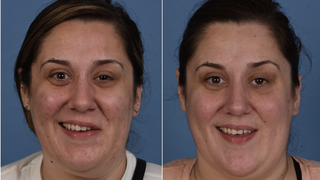Abnormal facial motion (synkinesis) is an abnormal motion that develops after a partial recovery of the facial nerve. It may appear following Bell's palsy. Ocular-oral synkinesis, a common form of synkinesis, is characterized by eye closure when attempting to smile.
The severity of synkinesis may vary from very little deformity to significant asymmetry. Treatments differ based on the degree of abnormality and differing philosophies in the medical community.
No definitive approach to treating synkinesis exists but there are several strategies, including:
Botox
Patients may have a trial of Botox or use it on a regular basis every four months. This treatment is medically necessary and is covered by the majority of insurance companies. The goal of this treatment is to paralyze or partially paralyze the muscle groups that are involved, most commonly around the eyelids. Additional common places of injection are in the chin and less often in the midface region. This approach has yielded good results with high patient satisfaction.
Facial Retraining/Biofeedback
Results vary and are also dependent on the amount of time patients spend in therapy and their motivation. The principle behind this approach is to train patients to increase wanted movement while simultaneously decreasing unwanted motions.
This work is done under the supervision of a facial nerve therapist and requires significant commitment on the patient's part.







